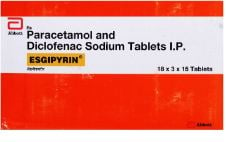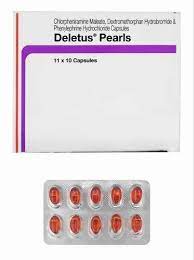Diclofam Plus R 50mg/325mg Tablet 10s DICLOFENAC + PARACETAMOL
Introduction to Diclofam Plus R 50mg/325mg Tablet 10s
Diclofam Plus R 50mg/325mg Tablet 10s is a combination medication primarily used for pain relief and inflammation reduction. This tablet is commonly prescribed for conditions such as arthritis, menstrual pain, and acute injuries. It combines the benefits of Diclofenac and Paracetamol to provide effective relief.
Composition of Diclofam Plus R 50mg/325mg Tablet 10s
Diclofam Plus R 50mg/325mg Tablet 10s contains two active ingredients: Diclofenac and Paracetamol. Diclofenac is a non-steroidal anti-inflammatory drug (NSAID) that works by inhibiting enzymes responsible for producing inflammatory chemicals, thereby reducing pain and inflammation. Paracetamol, on the other hand, is an analgesic and antipyretic that blocks pain signals in the brain and reduces fever.
Uses of Diclofam Plus R 50mg/325mg Tablet 10s
- Arthritis
- Menstrual pain
- Acute injuries
- Osteoarthritis
- Rheumatoid arthritis
- Headaches
- Muscle aches
- Cold symptoms
Side effects of Diclofam Plus R 50mg/325mg Tablet 10s
- Stomach upset
- Nausea
- Headache
- Gastrointestinal bleeding (serious)
- Cardiovascular events (serious)
- Severe liver damage (in case of overdose)
- Allergic reactions (rare)
Precautions of Diclofam Plus R 50mg/325mg Tablet 10s
Diclofenac should be used with caution in individuals with a history of gastrointestinal bleeding, cardiovascular disease, or kidney impairment. It is contraindicated in those with known hypersensitivity to NSAIDs. Paracetamol should be used cautiously in individuals with liver disease or those who consume large amounts of alcohol.
How to Take Diclofam Plus R 50mg/325mg Tablet 10s
The usage method for Diclofam Plus R 50mg/325mg Tablet 10s is typically oral, as it is available in tablet form. Follow your doctor’s advice for the correct dosage and frequency, which usually involves taking the tablet with water, with or without food, as prescribed.
Conclusion of Diclofam Plus R 50mg/325mg Tablet 10s
Diclofam Plus R 50mg/325mg Tablet 10s is a combination medication containing Diclofenac and Paracetamol, used primarily for pain relief and inflammation reduction. It is effective in treating conditions like arthritis and acute injuries. Manufactured by a reputable pharmaceutical company, this tablet offers a balanced approach to managing pain and inflammation. Always consult your healthcare provider for personalized advice and dosage instructions.

Are the medicines in combination of Diclofenac and Paracetamol safe to take together?
While Diclofenac and Paracetamol can be used together for pain management, caution is advised when combining them with other medications. Diclofenac can increase the risk of bleeding when used with anticoagulants, and Paracetamol can enhance the effects of warfarin. Monitoring liver function is important when using Paracetamol, especially with other hepatotoxic drugs. Regular check-ups with a healthcare provider can help monitor for interactions and adjust dosages as needed to ensure safety and effectiveness.

Are there harms and risks from taking combination of Diclofenac and Paracetamol?
Common side effects of Diclofenac include gastrointestinal issues such as stomach pain, nausea, and diarrhea. It can also cause more serious effects like ulcers and increased risk of heart attack or stroke with long-term use. Paracetamol is generally well-tolerated, but overdose can lead to severe liver damage. Both medications can cause allergic reactions, though this is rare. It's important to use these medications as directed to minimize risks and consult a healthcare provider if any severe side effects occur.

Can I take combination of Diclofenac and Paracetamol if I am pregnant?
Paracetamol is generally considered safe for use during pregnancy when used as directed, as it does not pose significant risks to the fetus. Diclofenac, however, should be avoided, especially in the third trimester, due to potential risks such as premature closure of the fetal ductus arteriosus. Pregnant women should consult their healthcare provider before using these medications to ensure safety and to discuss any potential risks and benefits.

Can I take combination of Diclofenac and Paracetamol while breastfeeding?
Paracetamol is generally considered safe for use during breastfeeding, as it is excreted in breast milk in small amounts and is unlikely to harm the infant. Diclofenac, however, should be used with caution during lactation, as its safety profile is less established. It's important for breastfeeding mothers to consult with a healthcare provider before using these medications to ensure the safety of the infant and to discuss any potential risks and benefits.

Can I take combination of Diclofenac and Paracetamol with other prescription drugs?
Diclofenac can interact with anticoagulants like warfarin, increasing the risk of bleeding. It may also interact with other NSAIDs, increasing the risk of gastrointestinal issues. Paracetamol can interact with warfarin, potentially enhancing its anticoagulant effect. Both medications should be used cautiously with other drugs that affect liver function. It's important to inform your healthcare provider of all medications you are taking to avoid potential interactions and ensure safe use of Diclofenac and Paracetamol.

For how long is combination of Diclofenac and Paracetamol taken?
Diclofenac and Paracetamol are typically used for short-term relief of pain and inflammation. Diclofenac is often prescribed for acute conditions and should not be used for extended periods due to potential cardiovascular and gastrointestinal risks. Paracetamol can be used for longer durations but should not exceed the recommended daily dose to avoid liver damage. Both medications are effective for managing pain, but long-term use should be monitored by a healthcare provider to prevent adverse effects.

How does combination of Diclofenac and Paracetamol work?
Diclofenac works by inhibiting cyclooxygenase (COX) enzymes, which are involved in the production of prostaglandins that cause inflammation and pain. This makes it effective for reducing inflammation and pain in conditions like arthritis. Paracetamol, on the other hand, acts centrally in the brain to reduce pain and fever, though its exact mechanism is not fully understood. Both medications provide pain relief, but Diclofenac also addresses inflammation, making them complementary in managing various types of pain.

How does one take combination of Diclofenac and Paracetamol?
Diclofenac should be taken with food or milk to minimize gastrointestinal discomfort, while Paracetamol can be taken with or without food. It's important to follow the prescribed dosage and not exceed the recommended daily limits for either medication. Patients should avoid alcohol while taking Paracetamol to prevent liver damage. For Diclofenac, it's advisable to avoid other NSAIDs to reduce the risk of gastrointestinal bleeding. Both medications should be used as directed by a healthcare provider to ensure safety and effectiveness.

How do I know if combination of Diclofenac and Paracetamol is working?
The benefit of Diclofenac and Paracetamol is assessed by the reduction in pain and inflammation, as well as the improvement in the patient's ability to perform daily activities. Diclofenac's effectiveness is often measured by its ability to reduce inflammation and swelling, particularly in conditions like arthritis. Paracetamol's benefit is gauged by its ability to lower fever and alleviate general pain. Both medications are considered effective if they provide significant relief from symptoms without causing adverse side effects.

How do I store combination of Diclofenac and Paracetamol?
Both Diclofenac and Paracetamol should be stored at room temperature, away from excess heat and moisture. They do not require refrigeration. It's important to keep these medications in their original containers, tightly closed, and out of reach of children to prevent accidental ingestion. Proper storage ensures the effectiveness and safety of the medications over time. Always check the packaging for specific storage instructions and expiration dates.

How effective is combination of Diclofenac and Paracetamol?
Diclofenac's effectiveness is supported by clinical trials demonstrating its ability to reduce inflammation and pain in conditions like arthritis and acute injuries. Paracetamol is widely used and proven effective for pain relief and fever reduction, with a well-established safety profile when used as directed. Both medications are commonly prescribed and have been shown to provide significant symptom relief in various studies. Their combined use can offer a broader spectrum of pain management, addressing both inflammation and general pain.

How long does it take for combination of Diclofenac and Paracetamol to work?
Diclofenac and Paracetamol both work to relieve pain, but they have different onset times. Diclofenac, a nonsteroidal anti-inflammatory drug (NSAID), typically begins to relieve pain within 30 minutes to an hour after ingestion. Paracetamol, also known as acetaminophen, usually starts working within 30 minutes. Both medications are used to treat mild to moderate pain, but Diclofenac also reduces inflammation, which Paracetamol does not. The combination of these two can provide a more comprehensive approach to pain management, addressing both pain and inflammation.

What disease or symptom is combination of Diclofenac and Paracetamol used for?
Diclofenac is indicated for conditions involving inflammation and pain, such as osteoarthritis, rheumatoid arthritis, and ankylosing spondylitis. It is also used for acute musculoskeletal injuries and menstrual pain. Paracetamol is commonly used for mild to moderate pain relief, such as headaches, muscle aches, and fever reduction. It is also effective for osteoarthritis pain. Both medications are used to manage pain, but Diclofenac is particularly effective for inflammatory conditions, while Paracetamol is often used for general pain and fever.

What is combination of Diclofenac and Paracetamol?
Diclofenac and Paracetamol are commonly used to relieve pain and reduce fever. Diclofenac, an NSAID, works by inhibiting enzymes that cause inflammation and pain, making it effective for conditions like arthritis. Paracetamol, on the other hand, reduces pain and fever by acting on the brain's heat-regulating center and altering the perception of pain. Together, they provide a comprehensive approach to managing pain, with Diclofenac addressing inflammation and Paracetamol offering general pain relief.

What is the usual dose of combination of Diclofenac and Paracetamol?
For Diclofenac, the usual adult dose is 75 to 150 mg per day, divided into two or three doses. For Paracetamol, the typical adult dose is 500 mg to 1000 mg every 4 to 6 hours, not exceeding 4000 mg per day. Both medications should be taken as directed by a healthcare provider to avoid potential side effects. Diclofenac is particularly effective for inflammatory pain, while Paracetamol is commonly used for general pain relief and fever reduction. It's important to adhere to the recommended dosages to prevent liver damage from Paracetamol and gastrointestinal issues from Diclofenac.

Who should avoid taking combination of Diclofenac and Paracetamol?
Diclofenac is contraindicated in individuals with a history of heart disease, gastrointestinal bleeding, or ulcers. It should be used with caution in patients with kidney or liver impairment. Paracetamol should not be used in excess of the recommended dose due to the risk of severe liver damage. Both medications should be avoided in individuals with known allergies to their components. It's crucial to follow dosing instructions and consult a healthcare provider if there are any concerns or pre-existing conditions.
















.svg)
